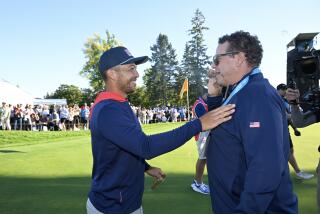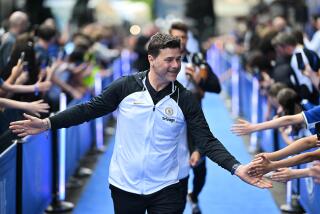America’s Cup Update : Americans’ Lack of Cooperation Puzzles Some
- Share via
Leave it to Terry Neilson, a Canadian, to tell the Americans how easily they could reclaim the America’s Cup from Australia, and why they may not.
“There are too many big egos involved,” said Neilson, the skipper of Canada II. “I can’t believe the Americans weren’t smart enough to get together and try to win the thing. It’s kind of funny that two of the syndicates that were working together are from different countries.”
For 10 months Neilson sailed alongside Buddy Melges’ Heart of America effort, one of six American syndicates. They shared ideas and took turns using one another’s boats as fixed performance platforms for the other so that both could improve.
“We get along well and we’re both lower key on the security side,” Neilson said. “We consolidated the information we learned, so that gave us a real advantage over other camps.”
It seems to have paid off for the Canadians. In early practice sparring off Perth before the first round of competition starts a week from Saturday, they have had one of the faster boats, albeit an old one.
The Canadians have been sailing with Newport Beach’s Eagle, but the American syndicates generally don’t talk to each other for fear of revealing a secret--as if there are any secrets left.
Should they meet while practicing on the race course, it might not mean much.
Sandy Purdon, executive administrator for Dennis Conner’s Sail America, said: “They’ll all be sandbagging. If somebody comes alongside you’ll put your trim tab on hard right, and the other guy will probably have his on, too.”
A trim tab is a control surface on the trailing edge of the keel. Overtrimmed, it can serve as a brake.
Melges went to San Francisco Bay last spring to sail with the Golden Gate effort skippered by Tom Blackaller, who after the Aussie win in 1983 had criticized Dennis Conner for not cooperating with other American programs.
That series ended in hard feelings, though, so when Melges returned West with his new boat early this summer, he went to nearby Santa Cruz to sail with the Canadians.
The three California syndicates never did get together for mutual benefit. Conner isolated himself in Hawaii, Blackaller chose to stay in San Francisco and Eagle remained in Long Beach to tune against its own beefed-up trial boat, Magic.
Eagle, the Newport Harbor Yacht Club entry, did work with one of the Italian syndicates, but that was seen as a one-way benefit for the Italians.
“I’m just surprised that Blackaller and Eagle couldn’t work something out, or Blackaller and Buddy Melges,” Neilson said. “Same thing with Conner. He was off by himself in Hawaii. I think if they consolidated a bit they could make sure they’d win the Cup.”
It’s too late now. All of the boats are in Australia or en route, soon to be joined by their crews. Some competitors would say that Neilson’s points are moot, anyway, because the America’s Cup is not nationalistic, that it is a competition among yacht clubs, not countries.
Tell that to the Australians.
Neilson, 27, believes that the two Canadian syndicates--Canada II and True North--were smart to consolidate their efforts earlier this year, thus multiplying their chance for success.
“If there wasn’t a merger, I think both syndicates would have gone bankrupt,” Neilson said. “There also were some problems in the True North camp with morale, but once we put the two together, we got the best sailors in Canada.
“Then when Canada II proved how fast she was--quite a bit faster than True North--we got the confidence in the boat.”
Two years ago, Neilson was about as far removed from the America’s Cup as one can be while still afloat. He sailed a one-man Finn dinghy to a bronze medal in the Olympic Games at Long Beach. Until 11 months ago, he had never sailed anything bigger than 30 feet. Suddenly, he was in command of a craft more than twice that size.
“What you do in a dinghy compared to these 12-meters is very similar,” he said. “All you’re doing is concentrating, whether it’s the (wind indicator) ribbons on the jib or the knotmeter. You’ve done that for 15 years.
“But the communication involved is very different. In the Finn, that obviously is not a problem. You’re the only one in the boat. But when you have 11 people on board and another 8 on shore that are sailing the next day, and then 20 support crew for maintenance, it’s a large company.”
Other Finn sailors have adjusted successfully. John Bertrand, who won a silver for the U.S. in ‘84, is America II’s tactician and alternate helmsman. The other John Bertrand, a two-time Olympic Finn contestant from Australia, steered Australia II to victory in ’83.
Accustomed to making all of their own decisions, they seem to move smoothly into positions of command, but not so smoothly into subordinate roles.
Russell Coutts, the gold-medal winner in ‘84, was part of the New Zealand’s crew for a while but apparently missed the satisfaction of controlling his own destiny.
When the Canadians merged, Neilson was nominated as helmsman over True North’s more experienced Hans Fogh.
“It’s hard to say why I was chosen,” Neilson said. “I guess he was so good in his area of boat speed that we thought we’d be wasting his talents if he was sitting there concentrating on steering.
“A lot of people think the helmsman is the most important job, but steering isn’t that difficult. Making the boat go fast is quite a bit harder. Hans made all the sails for the boat at North Sails Fogh in Toronto. He’s got two Olympic medals and a lot of experience. He makes sure the sails are looking good and the mast bend is right and all of that.”
Canada II is really the old Canada I rebuilt from the ’83 campaign.
“I was surprised,” Neilson said. “(Designer) Bruce Kirby wanted to add a winged keel and change the bow and stern to see how that would work, and we were gonna build another boat from what we learned.
“As it turned out, the boat was so fast that we decided to put the money into sails and put a lot of time on the water. We could focus our attention on crew work and sail shape.”
Neilson isn’t sure about some of the other boats.
Of Golden Gate’s radical design, he said: “I think they went out on a bit of a limb. Who knows? Maybe having a rudder in the front is great, but it’s a bit of a chance. We’ll know when we get beside ‘em.”
“(As for) Eagle, (skipper Rod) Davis is a very bright guy and they have a good group of people, but who knows how fast the boat is? They’ve got big, bloody wings on the bottom--the biggest wings I’ve ever seen.
“Success in this stuff is directly linked to your boat speed. It’s so boat-speed oriented that sometimes it’s a little boring. If you have a slow boat, you’re gonna have a hard time no matter how smart you are. If you’re close, the smarts will help a lot.”


